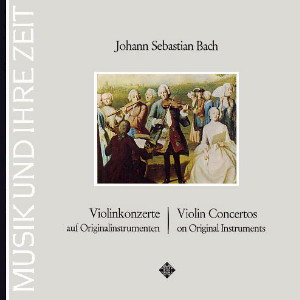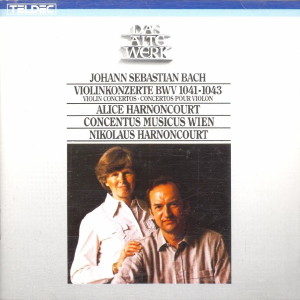 |
1 LP -
SAWT 9508-A - (p) 1967
|
 |
| 1 CD -
8.41227 ZK - (c) 1984 |
|
| Johann Sebastian
Bach (1685-1750) - Violinkonzerte
auf Originalinstrumenten |
|
|
|
|
|
|
|
| Konzert für zwei Violinen
d-moll, BWV 1043 |
|
16' 31" |
|
| - Vivace |
4' 12" |
|
A1 |
- Largo
ma non tanto
|
7' 06" |
|
A2 |
| - Allegro |
5' 13" |
|
A3 |
| Konzert
für Violine E-dur, BWV 1042 |
|
17' 47" |
|
| - Allegro |
8' 20" |
|
A4 |
- Adagio
|
6' 31"
|
|
B1 |
| - Allegro assai |
2' 56" |
|
B2 |
| Konzert
für Violine a-moll, BWV 1041 |
|
14' 51" |
|
| - Allegro |
4' 10" |
|
B3 |
- Andante
|
6' 29" |
|
B4 |
| - Allegro assai |
4' 12" |
|
B5 |
|
|
|
|
Alice Harnoncourt,
Solo-Violine (BWV 1041-1043)
|
|
Walter Pfeiffer,
Solo-Violine (BWV 1043)
|
|
|
|
| CONCENTUS MUSICUS
WIEN (mit Originalinstrumenten) / Nikolaus
Harnoncourt, Leitung |
|
| -
Peter Schoberwalter, Violine |
-
Kurt Theiner, Viola |
|
| -
Stefan Plott, Violine |
-
Nikolaus Harnoncourt, Violoncello |
|
| -
Walter Pfeiffer, Violine |
-
Eduard Hruza, Violone |
|
| -
Josef de Sordi, Violine |
-
Herbert Tachezi, Cembalo |
|
|
Luogo
e data di registrazione
|
| Vienna (Austria)
- gennaio 1967 |
|
Registrazione
live / studio
|
| studio |
Producer
/ Engineer
|
Wolf
Erichson
|
Prima Edizione CD
|
Teldec
"Das Alte Werk" - 8.41227 ZK - (1 cd) -
49' 09" - (c) 1984 - AAD
|
Prima
Edizione LP
|
Telefunken "Das
Alte Werk" - SAWT 9508-A
- (1 lp) - 49'
09"
- (p) 1967
|
|
|
Notes
|
In the Concerto in
D minor for two solo violins,
the dialogue does not take place, as
one might expect, between the solo
instruments, but between both
instruments and the orchestra. To make
the music "speak" was one of the chief
desires of composers and performers.
The articulation of the semiquaver
notes, as in the first movement of
this concerto, must thus always be
varied, far removed from the uniform
"Bach stroke". - ln the slow movement
the orchestra has only a continuo
function. The two solo instruments vie
with one another in their wonderful
melody, while here again the great
line may not inhibit the details of
the phrasing. The present-day ideal of
continuo sostenuto playing was foreign
to the musicians of that time; each
note had to "have its proper strength
and weakness". Bach’s phrasing is
meticulous in the extreme, and never
to be understood as mere bowing marks
but as specifically required
articulation. - The old requirement
"in each bar a different emotion" is
very clearly realized in the third
movement. In the middle of the hectic
chase of the opening tutti there are
two imploring interjections by the
soloists which are brusquely rejected
by the orchestra. The main motif of
the solo violins is formed from these
interjections. The orchestra adheres
to the impetuous opening motif
throughout the movement. Specifically
prescribed springing types of bowing
give rise to jazz-like shifts of
accent. Extreme contrasts are the main
feature of this movement.
The Concerto in E major is,in
the relative weight of its movements,
almost reminiscent of an
ouverture-suite. In the broadly
conceived first movement the orchestra
carries the main part of the musical
substance, whereas the solo is always
of a dreamily improvisatory character.
The Adagio cadenza of this movement is
composed without a bass; the chords
otherwise played here are from the
harpsichord version of the concerto. There
they make sense, since such a melody
in a single part sounds senseless on
the harpsichord, a chordal instrument;
on the violin the empty, completely
free descent particuarly underlines
the spontaneous, improvisatory
character ofthis part. - The slow
movement is constructed on an ostinato
bass. Here the soloist has the
opportunity, as already in the first
movement, for baroque rubato playing.
In the accompanying string parts Bach
uses the popular effect of the bow
tremolo or bow vibrato; the orchestra
accompanies the soloist in chords
“with a pulsating hand in which the
bow is held, in the manner of the
Tremulant on the organs..." (Farina,
17th century). These weighty movements
are followed by a light Rondo, in the
episodes of which the solo part leads
ever new transformations of arpeggio
figures to a turbulent conclusion. In
the two outer movements of the Concerto
in A minor the thematic material
of the introduction is given
exclusively to the orchestra, while
the solo passages are strongly
contrasted to it in expression. In the
accompaniment of some solo passages of
the first movement, Bach again uses
the bow vibrato described above. - In
the slow movement, the basso ostinato
is not played exactly in rhythm as
noted down but, in accordance with the
rules of the time, the demisemiquaver
group is played somewhat late. The
Finale acquires a dance-like character
through the rhythm and forward-driving
energy of the gigue.
Die Instrumente:
- Violine: Jacobus Stainer, Absam 1658
- Violine: Jacobus Stainer, Absam 1677
- Violine: Klotz Mittenwald, 18. Jh.
- Violine: Furber, London 1804
- Viola: Marcellus Hollmayr, Wien 17.
Jh.
- Violoncello: Andrea Castagneri,
Paris 1744
- Violone: Antony Stefan Posch, Wien
1729
- Cembalo: Kopie eines italienischen
Kielflügels um 1700 von M. Skowroneck,
Bremen 1957
|
|
Nikolaus
Harnoncourt (1929-2016)
|

|

|
|